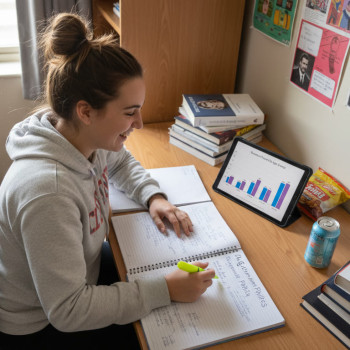Why Stress Management Matters for AP Students (and How Parents Can Help)
AP classes are a major step up: richer content, faster pacing, higher expectations. For many teens this brings not just academic challenge but a steady hum of stress—worry about grades, fears about college admissions, and the pressure to balance extracurriculars. As a parent, you’re in a powerful position to help. You don’t need to be a counselor or a meditation teacher; you simply need a few practical tools and scripts that you can use at home to steady the nerves, sharpen focus, and restore perspective.

How Breathing Helps (In Plain English)
Breathing is one of the fastest, most reliable ways to regulate the nervous system. When a student’s heart races before an AP exam or a big presentation, their breath becomes shallow and quick. That tells the brain it’s time to stay anxious. Slowing the breath sends the opposite signal: we are safe, we can think clearly, and the body can shift from panic mode into problem-solving mode.
There’s science behind it, but you don’t need to explain neuroscience to your teen. What matters is the experience: a few slow, intentional breaths will often reduce tension in 60–90 seconds and restore clearer thinking in a few minutes.
Quick Benefits to Remind Your Teen
- Immediate reduction in racing thoughts and physical tension.
- Better ability to focus on tricky exam questions.
- Improved memory recall by calming the mind before retrieval.
- A simple skill they can use anytime—no gadgets, no waiting.
Simple, Parent-Friendly Breathing Exercises
Below are short, easy-to-remember breathing techniques and scripts that you can coach your child through. They’re designed to be used in the hallway before an exam, at the kitchen table during a stressful study session, or during a midnight panic check-in.
1. The 4-4-4 Reset (Great for quick grounding)
Why it works: Rhythmic breathing stabilizes heart rate and attention.
How to do it (script you can say):
- “Sit comfortably. Close your eyes if you like. Breathe in through your nose for 4 seconds… hold for 4 seconds… and breathe out for 4 seconds. Let’s do that three times together.”
Coaching tip: Count out loud the first few times so they can match the rhythm. It becomes a private anchor—teens can do it under the desk, in a bathroom stall, or before a test begins.
2. Box Breath with a Twist (Focus + calm)
Why it works: Builds attention while calming the nervous system—useful when a student feels overwhelmed by a long exam or a heavy study load.
How to do it (script you can say):
- “Imagine drawing a square. Breathe in for 4 counts as you draw the first side. Hold for 4 counts as you draw the top. Breathe out for 4 counts as you draw the second side. Hold for 4 counts as you complete the square. Repeat three times.”
Coaching tip: Encourage them to visualize a color or calming image while holding the breath to deepen the reset.
3. The 5-5-10 Calm (For acute test anxiety)
Why it works: Slowed exhale encourages relaxation; slightly longer exhale activates the body’s relaxation response.
How to do it (script you can say):
- “Breathe in for 5 seconds. Breathe out gently for 10. Focus on releasing any tightness with the out-breath. Do this three times.”
Coaching tip: Tell your student it’s okay if the counts feel long at first—this resets quickly with practice.
Reset Scripts: Gentle Words That Work
Calm words matter. A short, measured script from you can interrupt a spiraling chain of negative thoughts. Below are friendly, non-lecturing phrases you can use when your child looks overwhelmed.
Script for Before a Big Test
“Hey—let’s take two minutes together. Breathe with me: in for four, out for four. You’ve done the work. Your brain knows more than the worry does. Do that one more time and then just do the next question.”
Script for When They’re Procrastinating
“I get it—starting feels heavy. Try this: set a 20-minute timer, breathe with me twice, and we’ll check in afterwards. Small chunks beat the monster of ‘everything at once.’”
Script for After a Poor Grade or Test
“I’m sorry that felt so rough. Let’s breathe together for a minute, then tell me one thing you learned from this—just one—and one thing you’d like help with. We’ll make a short plan.”
When to Use Scripts vs When to Step Back
Timing and tone are everything. A scripted check-in can feel supportive when your teen is receptive, but it can add pressure if they’re already feeling cornered. Use these cues:
- If they’re visibly upset but receptive to touch or proximity, start with a short breathing phrase and ask permission: “Want to try breathing together?”
- If they shut down or snap, give space. Offer the script later in a calm moment: “I’ve got a quick reset that helps if you want it later.”
- Let them lead. Teenagers value autonomy. Offer tools, but don’t force them.
Practical Routines to Build Resilience Over Time
Breathing and short reset scripts are most effective when practiced casually, not just in crises. Here are routines you can weave into your family life that build muscle memory for calm.
Weekly “Check-In and Reset” (10 minutes)
- Pick one evening. Ask: “How was the week? Anything feel overwhelming?”
- Share one small victory each—then do a group 4-4-4 reset.
- End with a concrete, kind plan for the next week (e.g., 20-minute study blocks, two tutor sessions if needed).
Pre-Exam Ritual (5–10 minutes)
- Night before: light review—no cramming. Do a 5-5-10 calm together and encourage sleep-friendly habits.
- Morning of: easy breakfast, two rounds of 4-4-4, and a reminder: “Focus on one question at a time.”
A Table You Can Use: Simple Scripts and When to Use Them
| Situation | Quick Script | Breathing Tool | Why It Helps |
|---|---|---|---|
| Pre-exam jitters | “Breathe with me for three cycles—then do the first question.” | 4-4-4 Reset | Rapid grounding and focus before starting. |
| Mid-test panic | “Pause, look up, exhale slowly. One question at a time.” | 5-5-10 Calm | Lowers arousal so they can access knowledge. |
| Procrastination spiral | “Let’s do 20 minutes and then reward yourself.” | Box Breath (1–2 cycles) | Resets overwhelm and creates manageable focus windows. |
| After a setback | “Take five to breathe. Tell me one thing you learned.” | Any slow breathing | Normalizes mistakes and moves toward solution-focused action. |
How to Introduce These Tools Without Sounding Preachy
Try this three-step approach:
- Model it first. Do the breathing yourself when you’re stressed—kids notice authenticity.
- Make it casual. “I tried a two-minute breath before that meeting and it helped—want to try?”
- Celebrate small wins. Notice when they use it and say: “That looked calm. Nicely done.”
When to Bring in Extra Support (And How Tutoring Helps)
Breathing exercises are powerful, but they’re part of a toolkit. If your child regularly reports overwhelming anxiety, avoidance, sleep disruption, or declining grades, consider additional supports. This is where targeted academic help pairs well with stress management.
Personalized tutoring—like Sparkl’s tailored 1-on-1 guidance—can reduce anxiety by building confidence. When tutors create individualized study plans, break down complicated AP concepts, and offer focused practice, students often feel less stuck and less stressed. Sparkl’s expert tutors and AI-driven insights can point to gaps quickly, provide targeted practice, and reinforce calm study routines so that breathing tools and academic strategies work together.
Real-World Examples: How Families Use These Scripts
Example 1: Emma (AP Biology) had test anxiety. Her mom started a nightly 4-4-4 reset before quiet study. Emma paired that with two 25-minute study blocks and one short tutoring session per week. Within a month, tests felt less overwhelming and she reported sleeping better.
Example 2: Javier (AP US History) procrastinated on essays. His parent used the “20-minute timer + breathe” script. Javier added one Sparkl session to get an essay structure he trusted. The combination made the task feel doable and he stopped pulling all-nighters.
Common Pitfalls and How to Avoid Them
- Never force a breathing exercise. Offer, don’t demand. If a teen refuses, gently leave the script on the table and try again later.
- Avoid moralizing language like “you should” or “you need.” Use curiosity: “What helped you last time?”
- Don’t treat breathing like a cure-all. It’s a fast reset—combine it with study structure, sleep, and targeted academic help.
Short Daily Practice Plan (2–5 minutes total)
Consistency is more helpful than duration. Here’s a micro-plan to build habit:
- Morning: One 4-4-4 cycle before breakfast (30–60 seconds).
- Study start: One Box Breath cycle before the first study block (30–60 seconds).
- Evening: One 5-5-10 calm before bed to support sleep (1–2 minutes).
When practiced casually, these micro-resets become automatic tools that students reach for under stress.
How to Measure Progress
Look for behavior changes, not perfection. Useful markers include:
- Fewer late-night cram sessions and more consistent study blocks.
- Improved sleep or reduced bedtime worry.
- Fewer panic episodes before tests; ability to restart after a tough question.
- Better performance on practice tests when combined with focused tutoring.
Final Words: Small Habits, Big Impact
Helping your AP student manage stress is less about fixing a single test and more about teaching a lifelong skill: how to come back to calm in the middle of pressure. The breathing techniques and reset scripts above are simple, portable, and respectful of your child’s autonomy. Used alongside good study structure—like Sparkl’s personalized tutoring and tailored study plans when needed—they form a practical, compassionate approach to AP stress.
Keep it light. Celebrate effort. And remember: your steady presence is one of the most powerful tools your child has. When you offer a calm voice, a short reset, and practical help, you’re giving them permission to do their best without confusing effort with panic.

Quick Reference: 3 Scripts to Try Tonight
- Before studying: “Two breaths together, then 20 focused minutes. You’ve got this.”
- Before a test: “In for four, out for four. One question at a time.”
- After a tough grade: “Breathe for a minute. Tell me one thing you learned and one thing you want help with.”
If you’d like, I can package these into a printable one-page sheet for your refrigerator or phone lock screen—short reminders that fit into busy family life. Or, if you want a customizable script tailored to your teen’s AP subjects (AP Calculus, AP Literature, AP Chemistry, etc.), tell me which ones and I’ll craft specific prompts and a study-reset routine you can use this week.
























No Comments
Leave a comment Cancel